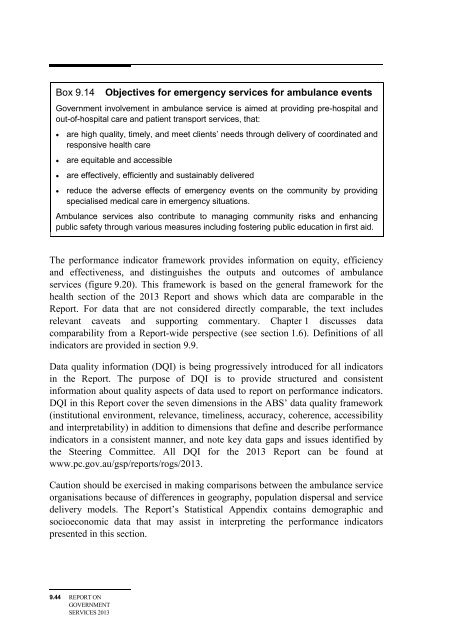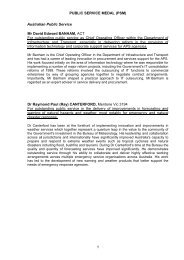13-government-services-2013-chapter9
13-government-services-2013-chapter9
13-government-services-2013-chapter9
Create successful ePaper yourself
Turn your PDF publications into a flip-book with our unique Google optimized e-Paper software.
Box 9.14 Objectives for emergency <strong>services</strong> for ambulance events<br />
Government involvement in ambulance service is aimed at providing pre-hospital and<br />
out-of-hospital care and patient transport <strong>services</strong>, that:<br />
• are high quality, timely, and meet clients’ needs through delivery of coordinated and<br />
responsive health care<br />
• are equitable and accessible<br />
• are effectively, efficiently and sustainably delivered<br />
• reduce the adverse effects of emergency events on the community by providing<br />
specialised medical care in emergency situations.<br />
Ambulance <strong>services</strong> also contribute to managing community risks and enhancing<br />
public safety through various measures including fostering public education in first aid.<br />
The performance indicator framework provides information on equity, efficiency<br />
and effectiveness, and distinguishes the outputs and outcomes of ambulance<br />
<strong>services</strong> (figure 9.20). This framework is based on the general framework for the<br />
health section of the 20<strong>13</strong> Report and shows which data are comparable in the<br />
Report. For data that are not considered directly comparable, the text includes<br />
relevant caveats and supporting commentary. Chapter 1 discusses data<br />
comparability from a Report-wide perspective (see section 1.6). Definitions of all<br />
indicators are provided in section 9.9.<br />
Data quality information (DQI) is being progressively introduced for all indicators<br />
in the Report. The purpose of DQI is to provide structured and consistent<br />
information about quality aspects of data used to report on performance indicators.<br />
DQI in this Report cover the seven dimensions in the ABS’ data quality framework<br />
(institutional environment, relevance, timeliness, accuracy, coherence, accessibility<br />
and interpretability) in addition to dimensions that define and describe performance<br />
indicators in a consistent manner, and note key data gaps and issues identified by<br />
the Steering Committee. All DQI for the 20<strong>13</strong> Report can be found at<br />
www.pc.gov.au/gsp/reports/rogs/20<strong>13</strong>.<br />
Caution should be exercised in making comparisons between the ambulance service<br />
organisations because of differences in geography, population dispersal and service<br />
delivery models. The Report’s Statistical Appendix contains demographic and<br />
socioeconomic data that may assist in interpreting the performance indicators<br />
presented in this section.<br />
9.44 REPORT ON<br />
GOVERNMENT<br />
SERVICES 20<strong>13</strong>






